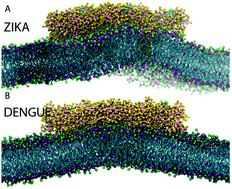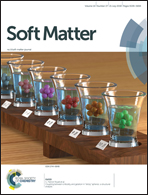Different footprints of the Zika and dengue surface proteins on viral membranes†
Abstract
The flavivirus Zika virus (ZV) became an international emergency within two years of its outbreak in the Americas. Dengue virus (DENV), which is also a flavivirus, causes significant clinical harm in equatorial regions. A common feature amongst flaviviruses like ZV and DENV is an icosahedral shell of exactly 180 copies of the envelope (E) and membrane (M) proteins anchored in a lipid membrane, which engulfs the viral RNA and capsid proteins. Host recognition by both ZV and DENV is linked to the presence of phosphatidylserine (PS) and phosphatidylethanolamine (PE) lipids in the viral lipidome. Glycosylation of Asn residues on the Zika E protein may be linked to ZV induced neuropathies. We carry out coarse grained molecular dynamics simulations of the E3M3 hexamer embedded in the ZV and DENV lipidomes, and we show that the proteins have a significantly different lipid footprint in the viral lipidome. PE lipids in DENV and PS lipids in ZV enrich near the protein hexamer. We attribute the difference to a higher number of cationic amino acids in the ZV M protein. We also show that the three glycosylation sites on ZV, but not on DENV, are conformationally variant. Our data shed new light on the lipid interactions, and thus the host recognition mechanisms of the two viruses, which may be molecular determinants of the neuropathies caused by the ZV.



 Please wait while we load your content...
Please wait while we load your content...